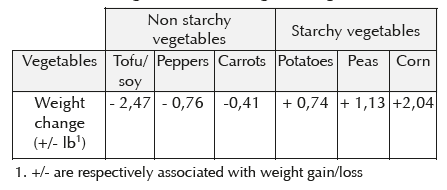Maintaining a healthy weight with the consumption of fruits and vegetables
Promoting healthy dietary patterns fits into the 2010 Dietary Guideline for Americans. In particular, it includes a variety of fruits and vegetables (F&V) to prevent chronic diseases, like cardiovascular disease, and to help individuals maintain a healthy weight. However, unlike cardiovascular diseases, there is a lack of evidence on specific types of fruits and vegetables that may help individuals maintain “a healthy weight”. This study examined the relationship between increased F&V consumption and weight change over 24 years of follow-up among Americans.
Fruits and vegetables to promote weight stability
F&V have several constituents that may aid in weight maintenance. Their fiber content and lower glycemic load (GL1), which produces smaller postprandial glucose spikes, may increase satiety and thus may reduce total energy intake. Furthermore, insulin sensitivity, the gut microbiome and the anabolic state of adipose tissue may be influenced by intake of polyphenols which come from plant foods like F&V. All of these components and biologically active constituents may promote weight stability.
Dietary and weight change assessment
From 1986 to 2010, a food frequency questionnaire (FFQ) was administered every 4 years (4-y) in three prospective cohorts of 133 468 Americans: the Nurses’ Health Study (NHS); the Health Professionals Follow-up Study (HPFS); and the Nurses’ Health Study II (NHS II). The 131-item FFQ included 44 line items for commonly consumed F&V. The latter were grouped into specific subgroups (with similar nutritional value) as well as high or low fiber content and GL:
- Fruits : citrus, melon, berries
- Vegetables : cruciferous, green leafy, legumes
Participants reported their weight on biennial questionnaires and weight change was calculated as the difference in weight between the beginning and end of each 4-y interval.
An inverse correlation between total F&V intake and weight change
Within each 4-y time interval, average weight gain in the three cohorts was +2,1 lb for men in the HPFS; +2,8 lb for women in the NHS; +5,0 lb for women in the NHS II. However, increased total fruit and total vegetable consumption was inversely correlated with weight change in all cohorts. An additional daily serving of total vegetables was associated with -0,25 lb less weight gained over 4-y and an additional daily serving of whole fruit was associated with -0,53 lb less weight gained. Increase the intake of berries, apples, pears, tofu, cauliflower, cruciferous and green leafy vegetables Specific subgroups of F&V were also inversely associated with weight change (Table 1).
Table 1 : Association between specific subgroups of fruits and vegetables and weight change

The association between individual F&V and weight change was also examined. Although increased intake of the majority of individual fruits was inversely associated with weight change, not all vegetables were inversely associated, for example, increased intake of starchy vegetables (potatoes, peas and corn) was associated with greater weight gain (Table 2).
Table 2 : Association between selected individual vegetables and weight change

Finally, the inverse correlation between F&V intake and weight change was stronger for berries (-1,11 lb), apples/pears (-1,24 lb), tofu (-2,47), cauliflower (-1,37 lb), cruciferous (-0,68 lb), and green leafy vegetables (-0,52 lb). Furthermore, increased intake of higher fiber and lower-GL vegetables was more strongly associated with negative weight change compared to lower fiber and higher-GL vegetables. This could reflect the impact of these factors on satiety, glucose and insulin responses, fat storage, and energy expenditure. Regarding starchy vegetables (potatoes, peas, corn), their association with weight gain could potentially be related to their higher GL, although they rank in the top half of vegetables based on fiber content and they have relevant nutritional value (potassium, vitamin C, B6, iron, fiber, protein).
More daily servings of F&V to reduce weight gain
Each increased daily serving of F&V was modestly associated with weight change but theoretically, an increase of one-to-two servings for F&V/day respectively could substantially reduce weight gain over the long-term. For example an additional daily serving of berries or summer squash was associated with about a lb less weight gained over each 4-y interval, which is half of the average weight gained by each male participant This study emphasizes the role of F&V intake in preventing long-term weight gain and thus obesity. Public health recommendations and nutritional guidelines should promote specific subgroups or individual F&V to maintain a healthy weight and prevent chronic diseases.
Based on: Bertoia ML, Mukamal KJ, Cahill LE, Hou T, Ludwig DS, Mozaffarian D, Willett WC, Hu FB, Rimm EB. Changes in intake of fruits and vegetables and weight change in United States men and women followed for up to 24 years: analysis from three prospective cohort studies. PLoS Med. 2015 Sep;12(9):e1001878.
References
- Carbohydrate content of each fruit/vegetable grams per serving multiplied with the glycemic index of that fruit/vegetable
